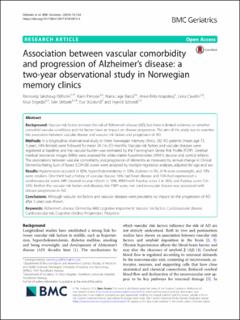| dc.contributor.author | Eldholm, Rannveig Sakshaug | |
| dc.contributor.author | Persson, Karin Ester Torun | |
| dc.contributor.author | Barca, Maria Lage | |
| dc.contributor.author | Knapskog, Anne Brita | |
| dc.contributor.author | Cavallin, Lena | |
| dc.contributor.author | Engedal, Knut | |
| dc.contributor.author | Selbæk, Geir | |
| dc.contributor.author | Skovlund, Eva | |
| dc.contributor.author | Saltvedt, Ingvild | |
| dc.coverage.spatial | Norge | en_US |
| dc.date.accessioned | 2020-03-06T15:01:40Z | |
| dc.date.available | 2020-03-06T15:01:40Z | |
| dc.date.issued | 2018 | |
| dc.identifier.citation | Eldholm et al. BMC Geriatrics (2018) 18:120 https://doi.org/10.1186/s12877-018-0813-4 | en_US |
| dc.identifier.issn | 1471-2318 | |
| dc.identifier.uri | https://hdl.handle.net/11250/2645875 | |
| dc.description.abstract | Abstract
BACKGROUND:
Vascular risk factors increase the risk of Alzheimer's disease (AD), but there is limited evidence on whether comorbid vascular conditions and risk factors have an impact on disease progression. The aim of this study was to examine the association between vascular disease and vascular risk factors and progression of AD.
METHODS:
In a longitudinal observational study in three Norwegian memory clinics, 282 AD patients (mean age 73.3 years, 54% female) were followed for mean 24 (16-37) months. Vascular risk factors and vascular diseases were registered at baseline, and the vascular burden was estimated by the Framingham Stroke Risk Profile (FSRP). Cerebral medical resonance images (MRIs) were assessed for white matter hyperintensities (WMH), lacunar and cortical infarcts. The associations between vascular comorbidity and progression of dementia as measured by annual change in Clinical Dementia Rating Sum of Boxes (CDR-SB) scores were analysed by multiple regression analyses, adjusted for age and sex.
RESULTS:
Hypertension occurred in 83%, hypercholesterolemia in 53%, diabetes in 9%, 41% were overweight, and 10% were smokers. One third had a history of vascular disease; 16% had heart disease and 15% had experienced a cerebrovascular event. MRI showed lacunar infarcts in 16%, WMH with Fazekas score 2 in 26%, and Fazekas score 3 in 33%. Neither the vascular risk factors and diseases, the FSRP score, nor cerebrovascular disease was associated with disease progression in AD.
CONCLUSIONS:
Although vascular risk factors and vascular diseases were prevalent, no impact on the progression of AD after 2 years was shown. | en_US |
| dc.description.sponsorship | The work by Rannveig S. Eldholm and Maria L. Barca was funded from the
Norwegian ExtraFoundation for Health and Rehabilitation through the
Norwegian Health Association. Rannveig S. Eldholm also received funding
from the Liaison Committee between the Central Norway Regional Health
Authority and the Norwegian University of Science and Technology (NTNU).
Karin Persson’s work was funded by the Southern and Eastern Norway
Regional Health Authority. | en_US |
| dc.language.iso | eng | en_US |
| dc.rights | Navngivelse 4.0 Internasjonal | * |
| dc.rights.uri | http://creativecommons.org/licenses/by/4.0/deed.no | * |
| dc.subject | Alzheimer’s disease; | en_US |
| dc.subject | Cardiovascular disease; | en_US |
| dc.subject | Cardiovascular risk; | en_US |
| dc.subject | Cognitive decline; | en_US |
| dc.subject | Dementia; | en_US |
| dc.subject | Mild cognitive impairment; | en_US |
| dc.subject | Prognosis; | en_US |
| dc.subject | Progression; | en_US |
| dc.subject | Vascular risk factors | en_US |
| dc.title | Association between vascular comorbidity and progression of Alzheimer's disease: a two-year observational study in Norwegian memory clinics | en_US |
| dc.type | Peer reviewed | en_US |
| dc.type | Journal article | en_US |
| dc.description.version | publishedVersion | en_US |
| dc.rights.holder | © The Author(s). 2018 Open Access This article is distributed under the terms of the Creative Commons Attribution 4.0
International License (http://creativecommons.org/licenses/by/4.0/), which permits unrestricted use, distribution, and
reproduction in any medium, provided you give appropriate credit to the original author(s) and the source, provide a link to
the Creative Commons license, and indicate if changes were made. The Creative Commons Public Domain Dedication waiver
(http://creativecommons.org/publicdomain/zero/1.0/) applies to the data made available in this article, unless otherwise stated. | en_US |
| dc.source.pagenumber | 8 | en_US |
| dc.source.volume | 18 | en_US |
| dc.source.journal | BMC Geriatrics | en_US |
| dc.source.issue | 120 | en_US |
| dc.identifier.doi | 10.1186/s12877-018-0813-4 | |
| dc.identifier.cristin | 1586104 | |

